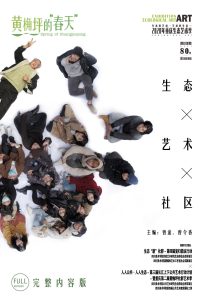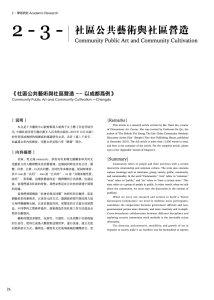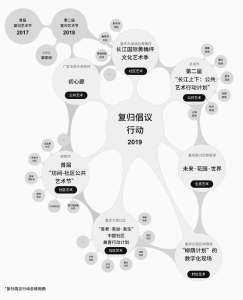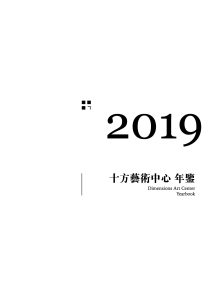歷史網站|Historical Website:
1. 社會項目|Social Projects:
通過藝術&社會項目的開展,十方在區域藝術生態構建、城市社區營造、傳統產業轉型、新農村建設、文化資源保護等方面實踐著藝術的力量。根據不同的項目類型,組建聯合專業工作團隊,團隊包括項目所需的各專業方向人才,如城市規劃、建築設計師,科學家,社會學者、民間手工藝人、藝術家、策展人、原住族群等,進而滿足項目的各方面專業需求,實現人才的跨界學習和協作。
The DAC art & society projects are designed to contribute to the development of the art and culture industry, shaping urban community life, transforming and upgrading traditional industries, and preserving cultural resources. Professionals such as urban planners, architects, scientists, sociologists, folk art craftsmen, artists, curators and local dwellers are recruited for those projects.
2. 藝術與教育 - 四川美術學院|Art and Education - Sichuan Fine Arts Institution:
2015年中旬,四川美術學院提出全面本科個性化教學改革計劃——特色工作室計劃應運而生,作為本項教學改革計劃的重要組成部分,曾途跨媒體特色工作室計劃旨在面對新的時代語境,基於中國的開放社會為藝術在地重生的場域,進行藝術研究、創作、教育的轉型與實驗。
2016年,四川美術學院實驗藝術學院開設「藝術與社會」專業教研室,這是繼四川美術學院個性化特色工作室計劃後,正式將美術學實驗藝術學科的本科教育方向引領進入以中國當代社會為語境的全新專業現場。
以上兩個事件,是中國社會新時代語境下,藝術高等教育所面臨的巨大時代變遷縮影,如何將藝術教育與社會生態交融,離開象牙塔與白盒子的舒適區,藝術生態如何真正扎根於中國的社會生態?十方作為一家以藝術在地為宗旨的民辦非企業社會組織,也在高校教育與社會現場間漸漸尋找到自己的位置,成為二者的紐帶和橋梁。
In mid-2015, Sichuan Fine Arts Institute proposed a comprehensive undergraduate personalized teaching reform plan—the specialized studio project came into being. As an essential part of this teaching reform plan, the Zengtu Cross Media Studio aims to face the new context of the times, based on China’s open society as a field for the rebirth of art, conducts the transformation and experimentation of art research, creation, and education.
In 2016, the School of Experimental Art of Sichuan Fine Arts Institute opened the “Art and Society” professional teaching and research section. This is to formally lead the undergraduate education of the experimental art subject of fine arts into a new professional scene in the context of contemporary Chinese society following the specialized studio project of the Sichuan Fine Arts Institute.
The above two events are the epitome of the significant changes that art education faces in the new era of Chinese society. How to integrate art education with society, leaving the comfort zone of ivory towers and white boxes of the gallery, and how art ecology truly takes root in China’s social ecology? As a private non-corporate social organization with local art, Dimensions Art Center has gradually found its place between art education and society and becoming a link and bridge between the two.
3. 藝術與公益 - 特殊人群公益項目|Arts and Philanthropy - Philanthropy Projects for Disadvantaged Groups:
藝術本身具有非功利性,這與公益事業的根本目標是契合的。但在現代社會學科分科和人們的日常經驗中,藝術和公益在價值訴求、工作方法、社會效益等方面都分屬不同領域。十方作為一個具有藝術專業背景的非盈利性社會機構,從合法註冊那天起,就兼具藝術與公益的雙重屬性。在實際工作中藝術和公益並沒有緊密交互融合,這給我們的工作帶來很大挑戰,但也是我們得以在這方面發力的契機。藝術家擁有許多創新性才能,可以為公益領域帶來新的思考方式和提升解決問題的能力,藝術家對於社會公益的責任和熱情,也需要表達呈現的方式。讓藝術家和公益人士協作,需要構建中間平台和新的工作方法,目前十方在這方面已經探索數年,創立了復合型的工作方法和團隊,以持續項目的方式建立起各種藝術與公益的中間橋梁,並顯現出一定的社會成效。我們開展了如下幾方面的實踐探索工作:一.支持殘障人士藝術能力發展;二.支持公益機構組織開展藝術活動;三.支持公益機構文創產業發展;四.與公益社工組織合作參與社群重構及社會基層治理。
Art itself is non-utilitarian, which is consistent with the fundamental goal of public welfare. But in the division of modern social disciplines and people’s daily experience, art, and general interest belong to different fields in terms of value appeal, working methods, and social benefits. As a non-profit social organization with a professional background in art, Dimensions Art Center has the dual attributes of art and public welfare from legal registration. In work, skill and public welfare are not near integrated, which brings significant challenges to our work, but it is also an opportunity to make efforts in this area. Artists have many talents, bringing new ways of thinking and improving public welfare’s problem-solving ability.
Artists’ responsibilities and enthusiasm for social welfare also need to be expressed in the way of presentation. It is necessary to build an intermediate platform and working methods to allow artists and charity individuals to collaborate. At present, Dimensions Art Center has been exploring this area for several years, creating a diverse working method and team, and establishing various arts and charity in the form of ongoing projects. We have carried out the following work: 1. Support the development of the artistic ability of the disabled; 2. Support the organization of art activities by public welfare organizations; 3. Support the development of the cultural and creative industry of public welfare organizations; 4. Cooperate with social welfare work organizations to participate in the building of community and governance of society.





